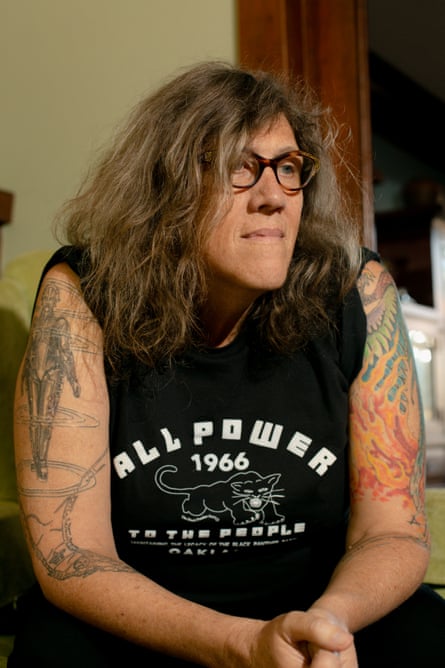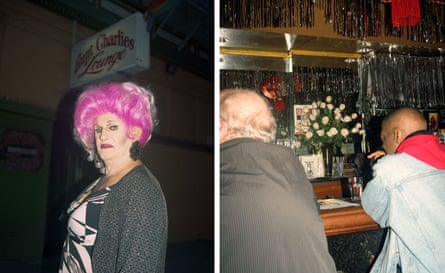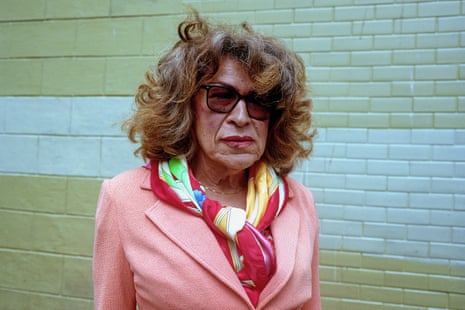Donna Personna does not want to be tolerated.
“I am to be loved, adored and respected,” the 72-year-old San Francisco woman declared on a recent morning, seated inside her fifth-story apartment. Personna is preparing to serve as grand marshal at the city’s Pride festival this year and has no patience for anyone’s tolerance: “Fuck that shit … Give me my rights.”
Her Pride mantra – “It ain’t a party. It’s time to act up” – honors the transgender women who, more than 50 years ago, showed her how to live and fight back.
In 1966, three years before the world-famous Stonewall riot in New York, a group of trans women in San Francisco stood up to police inside Gene Compton’s Cafeteria, an all-night restaurant in the Tenderloin neighborhood and popular queer gathering spot. A trans woman fed up with the harassment and abuse is said to have thrown a cup of coffee in an officer’s face, sparking a chaotic riot and unprecedented moment of trans resistance to police violence.
“These ladies took the bullets for us,” said Personna, a performer and activist who went to Compton’s Cafeteria as a teenager in the 1960s and now lives down the street. “Everyone in our community stands on their shoulders.”
As LGBT people across the US celebrate the 50th anniversary of Stonewall this month, trans community organizers in San Francisco are fighting to cement the legacy of their own groundbreaking riot – and have officially designated the world’s first-ever “trans cultural district” in the Tenderloin.
The cultural district is also mobilizing to protect black trans women from displacement, as the San Francisco neighborhood rapidly gentrifies.

Discovering the ‘screaming queens’
No one knows the exact date of the Compton’s Cafeteria riot. In fact, if it wasn’t for Dr Susan Stryker, the event might have been almost entirely forgotten.
The trans historian was rifling through the Gay and Lesbian Historical Society archives in 1991 when she stumbled on a timeline of historic events that referenced an August 1966 event: “Drag queens protest police harassment at Compton’s Cafeteria”.
The file included almost no additional information, and Stryker was determined to find out more. “There’s a story here that I need to tell,” she recalled in a recent interview in a coffee shop on San Francisco’s bustling Market Street, not far from the building where she first made that discovery.
It took Stryker years to figure out what happened. A city archivist told her there were no arrest reports, that the “records have been disappeared”. So she slowly built her own paper trail and learned how the corner of Turk and Taylor streets, where Compton’s was located, was “trans central”. Eventually, she met Amanda St Jaymes, a trans woman who had lived in a hotel in the area and was present at the riot.

St Jaymes and others told their stories in Stryker’s 2005 documentary, Screaming Queens, which included archival footage of a fearmongering TV news report that described the Tenderloin as a hotbed for “homosexuals and transvestites” to engage in the “marketplace of vice, degradation and human misery” – where “screaming queens” fought at Compton’s, a local diner.
Personna remembers things differently. When she was around 17, she hopped on a Greyhound bus from San Jose to San Francisco – and eventually wound up being a regular at Compton’s Cafeteria.
“They were the most beautiful women I’d ever seen,” said Personna, who was raised in a large Mexican family, with a Baptist minister father. “It was like I’m home, in a way … I really felt like I was in wonderland. They took care of me like big sisters. They were just so sweet to me and to each other.”
Trans women talked in the documentary about their struggles as sex workers in the neighborhood, and the ways they found brief refuge at Compton’s. The women often faced intense violence from clients and police, and would check up on each other and hang at the restaurant, Personna recalled.
The Tenderloin – two miles from the famous Castro gayborhood, which has long attracted white gay men – was in some ways safer for the women. But police would bother them wherever they went.
Collette LeGrande, a 68-year-old performer, recalled visiting Compton’s at age 15: “Meeting some of those girls, I thought they must have to be really strong.” She remembered seeing a policeman drag a trans woman and beat her with a club: “There was not much we could do about it.”
In Stryker’s film, the women talked about being arrested for all kinds of “crimes”, including “female impersonation” and “obstructing the sidewalk”. Their anger at the abuse erupted in the 1966 riot, prompted by an officer putting his hand on a woman at Compton’s. The women recalled throwing sugar shakers through the glass windows and drag queens beating police with their purses.
The night ended with overturned tables, a destroyed police car, a newsstand set on fire, and the women hauled off in officers’ paddy wagons.

Creating a trans district: ‘We need ownership’
The mainstream erasure of Compton’s from discussions of LGBT resistance is partly due to the exclusion of trans people from the gay rights movement and Pride parades in the years that followed.
LeGrande said she still encounters gay men in San Francisco who have never heard of it: “For the average LGB person … Stonewall is the beginning of the actual movement for them. But for the transgender girls, it’s Compton’s Cafeteria.”
A group of younger trans women are now working hard to make sure people don’t forget 1966. But honoring the Compton’s history in the Tenderloin is not just symbolic.
“It’s a life and death thing for many members of the trans community,” said Honey Mahogany, a San Francisco native and co-founder of the Compton’s Transgender Cultural District.
Mahogany, who previously worked as a social worker, has seen firsthand in recent years how trans people in the neighborhood struggle to access resources and housing – and are sometimes pushed out of San Francisco, with little support.
The Tenderloin has a reputation in California as being a magnet for homelessness, drug use and crime, with some calling it a “containment zone” for illegal activity. But as the tech boom has exacerbated income inequality, the Tenderloin is one of the rare areas that has maintained some affordable housing in the heart of the city, where low-income trans people of color continue to live and gather. For now.

“There is such a huge presence of trans folks – there’s nowhere else in the city, and maybe the world, where you see so many trans folks concentrated in a small area,” said Mahogany, 35.
Local organizers began discussing the creation of a historic district as a way to fight gentrification. The concept was later solidified during community negotiations with a real estate developer, who had gained approval from the city to tear down numerous historic LGBT sites to build a residential and hotel project. Activists opposed the destruction of landmarks, but were unable to stop the demolition and development.
A group led by black trans women, were, however, able to secure funding from the developer for community services and the official creation of the district, which covers six blocks and is considered the first legally recognized trans district in the world.
“What does it look like to honor the legacy and the culture we’ve inherited as trans people – a culture of joy and resilience, in spite of our disparities and marginalization?” said Aria Sa’id, the co-founder and executive director of the district, who moved from Oregon to San Francisco when she was 19 years old and wound up homeless in the Tenderloin. “We can create a world where we are economically and culturally and socially empowered.”
Longer term, that means turning the district into a hub of services and opportunities for trans people, with more community space, housing, job training and businesses “owned and operated by and for trans people”, said Sa’id, 29.
Janetta Johnson, another co-founder of the district, said the project was a way of “paying for the damage that has been historically caused against black trans people. You treated us like shit for many, many, many years … Now, we need ownership.”
Stryker, the historian, said she would someday like to see the city take over the site of the Compton’s Cafeteria, which closed in 1972, and build some kind of community center for trans people. Currently, 111 Taylor Street is a Federal Bureau of Prisons “re-entry center”, run by Geo Group, a notorious private prison corporation.

‘The realities we face are still the same’
Honoring the Compton’s riot also means recognizing that many of the hardships of 1966 remain.
“As much as we feel we made progress,” said Sa’id, “the realities we face and disparities we still face are the same.”
That makes the need for the cultural district feel urgent – a necessary stand against gentrification, in the spirit of the “screaming queens” who stood up to police.
The needs are urgent. In a region with overwhelming tech wealth and a high concentration of billionaires, some low-income LGBT people who live in the Tenderloin suffer through horrific housing conditions. Mahogany, who works as an aide to a San Francisco supervisor, said she recently learned of a tenant in her district who was hospitalized after a decomposing body leaked fluids onto her from the ceiling above. Bedbugs, filth and “unlivable conditions” are common.
The TGI Justice Project, a trans rights not-for-profit led by Johnson, is now losing its space in the Tenderloin, a few blocks from the Compton’s site and near the Uber and Twitter headquarters. She has struggled to find a new home.
Cecilia Chung, a longtime trans activist in San Francisco, noted that trans women in the Tenderloin also continue to face police harassment – for sleeping on the street or other laws that criminalize the poor: “There are still a lot of people in the Tenderloin who are struggling to survive due to … discrimination they are suffering.”
At Pride, Personna said she wants to remind people that their rights are under attack, that “we’re back in the 1960s”, and that “it could get worse”.
When she reflects on Compton’s, the toughest part for her is recognizing that the women who rioted never got to live in a society that respected them.
Her eyes welled with tears as she shared the message she would give if she could speak to them now: “Ladies, you didn’t live in vain. Your life is serving a bigger purpose now … And your story is never going to die.”
